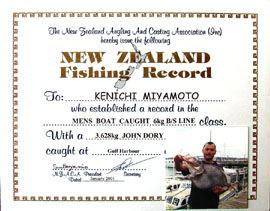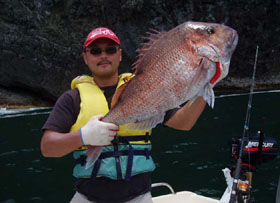Kenichi
Miyamoto
Birth Date: 9th February 1974
Birth Place: Shinjuku City, Tokyo Prefecture, Japan
Blood: B
Present Address: Auckland City, New Zealand

| KEN Yakitori New Zealand Ltd Director
Kenichi
Miyamoto |
 |
I started fishing in my 3rd grade of Primary School. Boys in their 5th grade
who were friends of my elder sister often took me fishing in the neighborhood.
Ifm not sure if anyone still fishes there, but the fishing spot during my childhood
was the outer moat of the koukyo imperial palace. I remember seizing Stone moroko,
Rosy bitterling, Koi carp, Crusiam carp, Back bass, Fresh water crayfish. I
would often cycle from my house in Shinjuku to moats found in Ichigaya and Akasakamitsuke
on my bicycle and all us kids would fish and swim. Thinking about it now, it
seems a little filthyc.
After completing school and growing into the society I would go to the sea to catch fishes like goby while I trained at a Yakitori Restaurant in Chiba Prefecture. Even though I couldnft fully get into it because I was busy with training, I always like fishing. I lived at a place called Gyoutoku, a city near a sea, and I saw an advertisement about Communal Jack Mackerel Charter boats. Back then I had no money and I would look at the fees for the ride and would cry as I couldnft afford them. I remember about it so clearly even now so I must have been really devastated at that time.
After opening a Yakitori Restaurant in New Zealand in 1997, I would spend half of my week on fishing from the shorelines. I would go alone to many spots, leaving the house when the sky is still dark in the morning. By the time I reached 26 years old I was able to spare some money so twice a month I would go on the gM. V. Verona Chartersh that departed from the Gulf Harbor. The skippers, Brain and Jocelyn took care of me very well. And when I was 27 I came to a point where I was able to buy a 19 feet Boat for $4000. The boat is quite an old model but since I donft have the confidence to sail much further out to the sea for fishing, I am quite satisfied with the boat. Even now, I have no intension of buying a better boat and thus I want to keep on treasuring my old model boat that was manufactured in year 1985.
During Senior High School I bought Eos Canon single lens reflex camera with money that I saved up over time and I began photography as a hobby. I have always enjoyed photographing fishes that I have caught, but the my greatest turning point was my meeting with Hideto Konishi. Konishi is the author of gYu-Yu Fish Encyclopediah and there is no mistake that our encounter triggered my gConcern towards Fish Photographyh. Now not only fishing but I have great interest and wonder towards fishes themselves and I am becoming more captivated as the day goes by. Rather than concerning about the size, even small, I enjoy fishing where you get to meet a kind of fish you have never seen before.
I always happen receive help from others when it comes to the identification of the fishes. The very beginning was when I encountered a Butterfly tuna at a fish market in Auckland. This unknown fish, that I have never come across before, set light to my curiosity. None of my friends couldnft name the fish and I couldnft even find it in the encyclopedia. Since I was determined to find out I put a photo of the fish on the BBS of gWEB Fish Encyclopediah website. Within minutes the answer gButterfly Fishh was put up, this person was Hideto Konishi, the person that I help me even now. Presently he has departed from gWEB Fish Encyclopediah and now is active in sites such as gFishing Diaryh and gYu-Yu Fish Encyclopediah. I have come across many other people through fish related BBSs and have been assisted by many people, particularly gsyouh, gMKTh, gMiyoh, gMSh and others. They are all very kind and nice. Refer to gLinkh as I have listed the sites that are related to them.
The procedures undertaken to indentify a fish is as to follows. Firstly I find
a fish and capture its details in a photo. In the case of a saltwater fish I
refer to gNew Zealand FISHESh, written by Larry Paul or gFish
Species of New Zealandh, by Jorge
Hirt-Chabbert. When I have fish from fresh water I look up gNew Zealand
FRESHWATER FISHESh, by R.M McDowall. I also refer to many other texts,
but usually you can find most fishes in the books that I have mentioned. Once
I identify the fish in the books I make note of both its New Zealand name and
technical name. Next, by using the technical name, I look up its Japanese name
by referring to the issues gCreature of New Zealand and surrounding
Oceanh published by ocean water resource development centre in Japan.
Now knowing its gJapanese nameh, gNew Zealand nameh, and gscientific nameh, I surf through gFishBaseh, a major fish related website, and find out its universal standard name, area of habitation, dimension and so forth. Once I have its gJapanese nameh, gNew Zealand nameh, gTechnical nameh, and the gUniversal standard nameh (in English), I would send those along with the photo of the fish and ask for opinions from all fish experts that I have mentioned earlier. After going through all these steps I finally come to the gIdentificationh of the fish. I have listed all the reference sites in the gLinkh section of this site.
Even going through my procedure it is still very difficult to identify a fish from photos. After all many researchers have spent tremendous amount of energy and time to study the world of fish and have undertaken the challenge to unravel its mysteries for many years. Now they are using DNA judgment system and many fishes that have been previously classified are being redefined day by day. So this field is nowhere a person such as me, a mere Japanese Restaurant director, to make opinions on. The reality is that the only way to know the real truth is to undergo the DNA judgment by having a real fish as a subject. But Ifm just hoping that I can, to a certain degree, introduce New Zealand fishes to people in Japan and maybe help people of New Zealand to have more interest in their fishes and their Japanese names.
In this site fishes that have standard Japanese names are listed with its Japanese names, but those who donft have standard Japanese names are listed with its English names that are found in gFishBaseh site, written katakana. Furthermore, finding the basis for the name of the fish is very difficult. This is because there are so many different local terms and names used in various places, so you may come across some unfamiliar names and terms you are not used to in this site. But whatfs wrong with using the local name gKingeeh rather than its English name gYellowtail kingfishh, or is there are need to call gSnapperh a gSquirefishh? I prefer when people talk casually in their local language and therefore use local names, I believe that how it should be naturally. But I must not be so lighthearted when it comes to creating an online encyclopedia, identifying something in that context, one must follow some sort of formal order and maintain accuracy. I would appreciate you keep this in mind when you are using my sight.
So I am introducing all the fishes after arguing and negotiating by going through all the above procedures. But if there are any researchers out there who encounter any problems or errors in my site, it would be greatly appreciated if you could let me know. I would try to correct or modify the issues as soon as possible.
Lastly I would like to send my great acknowledgements to my fishing-mates and
good friends Kenji Yazaki, Tadashi Aoyagi and Tetsuya Kurimasa.
